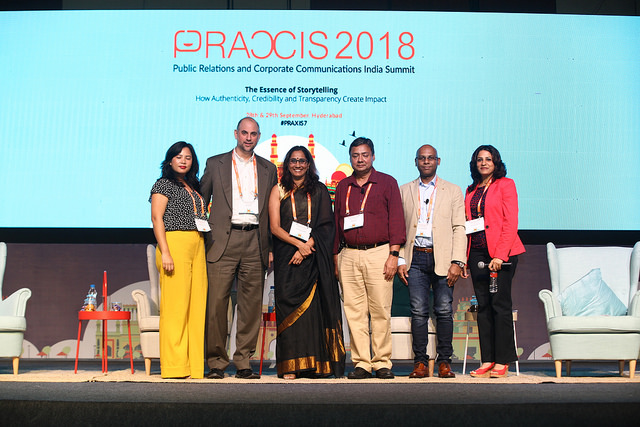Today, brand storytelling is all about creating a consistent experience and invoking emotion across different channels. Brand storytelling is at the heart of driving emotional connections with consumers, and we see that successful brands have showed they way by using different ways to tell stories. And, technology is central to this process.
This was the focal thought behind the Panel Discussion on Technology: An Enabler of Powerful Storytelling at PRAXIS7 on Day Two.
“We track 1.5 million data sources across the universe of the web and social media. The challenge is that the universe of social media is changing. And, the challenge for the technologist is that the customer needs it at the click of a button,” said Mukund Mudras, Heckyl Technologies. Whatever existed few months ago will be relevant now, as new entities are emerging. Technology is difficult to implement in a short span of time. But what is always the critical factor is how to be a step ahead.
Technology, in terms of Artificial Intelligence (AI) is very much top-of-mind today. Yangchen Yonzon, Meltwater addressed this fact, by saying that there is a lot of debate about how AI is going to change the world. “I believe that AI is already in our world”, she pointed out and insisted – “We need to embrace AI and need to stop looking at AI as that is going to replace us! The reality is that AI is going to augment the work we do.” She cited the example of AI rhythms, which tech providers give now, which can recommend the subject line of our press releases. “AI to me is about making our work more efficient” – ultimately, that’s the perspective that she projected.
To the thought put forward by Sunita Venugopal, Walmart Labs India, that – return in investment is actually moving to return on objectives, Sharat Jain, Impact Research & Measurement, shared – technology exists but we don’t always have the frame work! What is it that that you want to measure – the share prices hikes, the number of instruments sold or is measuring a relationship? To complicate the activity further is that every activity that the communicators do, makes it difficult for us to measure, because there are multiple campaigns, touch points etc. “But, we could look at some formats for measurement, who knows maybe next time in PRAXIS, we will have a reputation index!” he proclaimed.
Revealing that we have to move towards business methods in PR, was Abe Smith, Cision. If we can show the connection between reading an article to buying a ticket, then that takes it towards a real business matrix, he said. “So I think the motion around qualifying business outcome that a CEO or CMO or CFO cares about – that changes the language for PR and are also really business driven. Our peers in the other part of the marketing matrix, run paid ads, or work on owned media understand this,” he said. And, that changes the conversation dramatically. “That is the ROO language that want to have. And we can do that!”- was his confident statement.
“When we work with a CXO team there is a universal language they understand and a universal value that they see,” articulated Neelima Khanna, CARMA India. If you raise the bar, include research and analysis, there is a huge audience and huge resonance that you hold with the CXO community. Whether it is technology-enabled or human-enabled, the category of media intelligence is with you to go ahead, was her firm belief.
On the connect with citizen journalism, Yangchen expressed the fact that it has its pros and cons. The con was that when you democratise media so much, you run the risk of getting into the realm of fake news. It becomes difficult to control it or fix it, given the tech we have today. The pros are that it’s superb, she exclaimed. Looking at the history of media, we see that media has always been controlled by specific channels for so long. But when technology came into play, it democratised media – Facebook, Instagram, Snapchat, blogs etc. “It became engaging and gave power to people to share their viewpoint. So, sharing the stories from the grassroots have come into the limelight,” she noted.
On how PR technology is impacting B2B, Abe had the last word – “The truth is the same rules apply” whether you measure B2C or B2B level.






Be the first to comment on "Technology: An enabler of powerful storytelling"